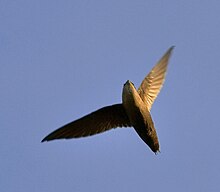Chimney swift
| Chimney swift | |
|---|---|
 |
|
| Flying in Texas, United States | |
| Scientific classification | |
| Kingdom: | Animalia |
| Phylum: | Chordata |
| Class: | Aves |
| Order: | Apodiformes |
| Family: | Apodidae |
| Genus: | Chaetura |
| Species: | C. pelagica |
| Binomial name | |
|
Chaetura pelagica (Linnaeus, 1758) |
|
 |
|
| Range of chimney swift Breeding range Wintering range | |
| Synonyms | |
|
Hirundo pelagica protonym |
|
Hirundo pelagica protonym
Chaetura pelasgia Stephens, 1825
The chimney swift (Chaetura pelagica) is a bird belonging to the swift family Apodidae. A member of the genus Chaetura, it is closely related to both the Vaux's swift and the Chapman's swift; in the past, the three were sometimes considered to be conspecific. It has no subspecies. The chimney swift is a medium-sized, sooty gray bird with very long, slender wings and very short legs. Like all swifts, it is incapable of perching, and can only cling vertically to surfaces.
The chimney swift feeds primarily on flying insects, but also on airborne spiders. It generally mates for life. It builds a bracket nest of twigs and saliva stuck to a vertical surface, which is almost always a human-built structure, typically a chimney. The female lays 4–5 white eggs. The altricial young hatch after 19 days and fledge a month later. The average chimney swift lives 4.6 years.
When he first described the chimney swift in 1758, Carl Linnaeus named it Hirundo pelagica, believing it to be a swallow. This misconception continued well into the 1800s, with ornithologists calling it "American Swallow" (e.g. Mark Catesby) or "Chimney Swallow" (e.g. John James Audubon). In 1825, James Francis Stephens moved this and other small, short-tailed New World swifts to the genus Chaetura, where it has since remained, although some authorities in the 1800s assigned it to a variety of now obsolete genera. It has no subspecies. The chimney swift's closest relative is the Vaux's swift. Scientists believe that the two species evolved from a common ancestor that was forced to North America's southeastern and southwestern corners by glacial advances. Separated for millennia by vast ice sheets, the survivors evolved into two species which are still separated by a wide gap across the continent's midsection. It is also closely related to the Chapman's swift; in the past, the three were sometimes treated as a single species.
...
Wikipedia

